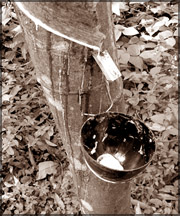Growers hit by falling rubber prices
by Dr. A. Nugawela - Director, Rubber Research
Institute of Sri Lanka
Rubber prices continued to decline at the Colombo Auctions last
month. The crepe rubber (1X) price dropped to Rs. 125 per kilogram from
Rs.208 per kg during the latter part of November. RSS 1 prices slumped
to Rs.150 per kg from Rs. 180 per kg with little or no interest shown by
the buyers.
 Due to the declining trend in natural rubber prices at the auction
rubber traders are uncertain of the price they should buy rubber. Due to the declining trend in natural rubber prices at the auction
rubber traders are uncertain of the price they should buy rubber.
The farm-gate prices are much lower than the auction prices and
growers who are uncertain are unable to sell their produce.
In certain areas RSS is purchased at Rs. 80 per kg on the
understanding that payments will be made later once the local traders
are able to sell their rubber. According to brokers, the demand for
natural rubber at the Colombo auctions is low due to global recession.
The price trends at the Colombo auctions are similar to the world market
trends.
The Singapore rubber prices dropped significantly during November.
The low rubber price scenario is more than a national issue and is
evident in all rubber growing countries.
In the backdrop of the global situation strategies to protect the
rubber growers and the industry have to be identified and implemented.
There should be strategies to enhance the demand for natural rubber
while curtailing production to match the demand without an adverse
effect on growers and workers.
Emerging economies such as China and India are less affected by the
global economic recession. India and China are large consumers of
natural rubber.
Government to government bi-lateral agreements could be used to
create a market and enhance the demand for Sri Lanka's natural rubber.
China and India consumed around 26 per cent and nine per cent of the
world natural rubber while Sri Lanka's contribution to the global
production was 1.2 per cent.
Sri Lanka imports natural rubber to cater to the needs of certain
product manufacturing industries. If this trend continues we will need
to stop imports to protect local growers. Local entrepreneurs could
embark on value addition if raw materials are available at a relatively
low cost. Items such as tyres could be manufactured locally.
The gap between the Colombo auction and farm-gate prices which is
high should be narrowed to acceptable levels. Growers should be made
aware of the Colombo auction prices through the media. Since there is no
established system for State involvement in purchasing rubber to
increase competition for raw material within the country the role of the
government in this regard is minimal.
The Thurusaviya Fund was launched to help rubber smallholders to
market their produce.
The quantity of RSS sold through the Colombo auctions is small. Local
consumers and exporters buy RSS from other markets. The supply chain
should be studied to identify how the price paid to growers could be
enhanced up to auction price levels.
If the price stabilisation fund was in operation the government could
have supported the growers during the poor trading period. The need for
such a fund is important when rubber prices improve.
According to brokers the demand for natural rubber is declining. The
cropping months will continue up to January. This situation will
certainly result in an over supply in the country unless the demand for
natural rubber increases drastically.
Growers should make a concerted effort to overcome this situation
which could be done by curtailing recovery tapping. Supply could be
controlled by not tapping a day per week in all new clearings though the
required growth standards are achieved.
It should be emphasized that these measures to curtail production is
aimed at improving the local market prices up to the Colombo auction
prices by attempting to match the supply situation to the demand. These
strategies will need to be adopted only until the objectives are met.
Financial losses by curtailing production could be compensated by more
favourable prices resulting from regulating the supply.
Rainguards will help to improve productivity and lower the cost of
production in large plantations where the fixed costs are high. For
smallholders the impact of rainguards on their cost of production will
be less. But the use of it by either sector will increase the supply
situation when the demand is less for the raw material.
The situation with regard to trading of natural rubber is changing
rapidly. An advisory group representing the relevant sectors and meeting
when the situation demands will help to generate and streamline
strategies needed to guide all stakeholders in the natural rubber
industry.
The cooperation of all stakeholders is vital to protect the natural
rubber industry in the country. |
